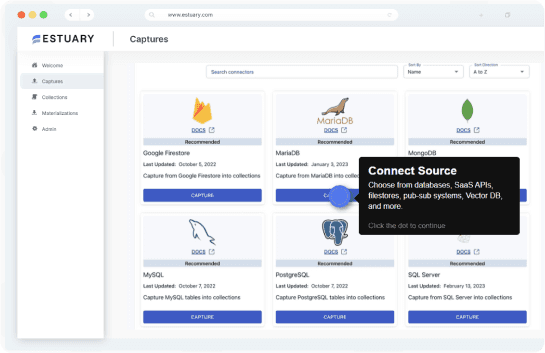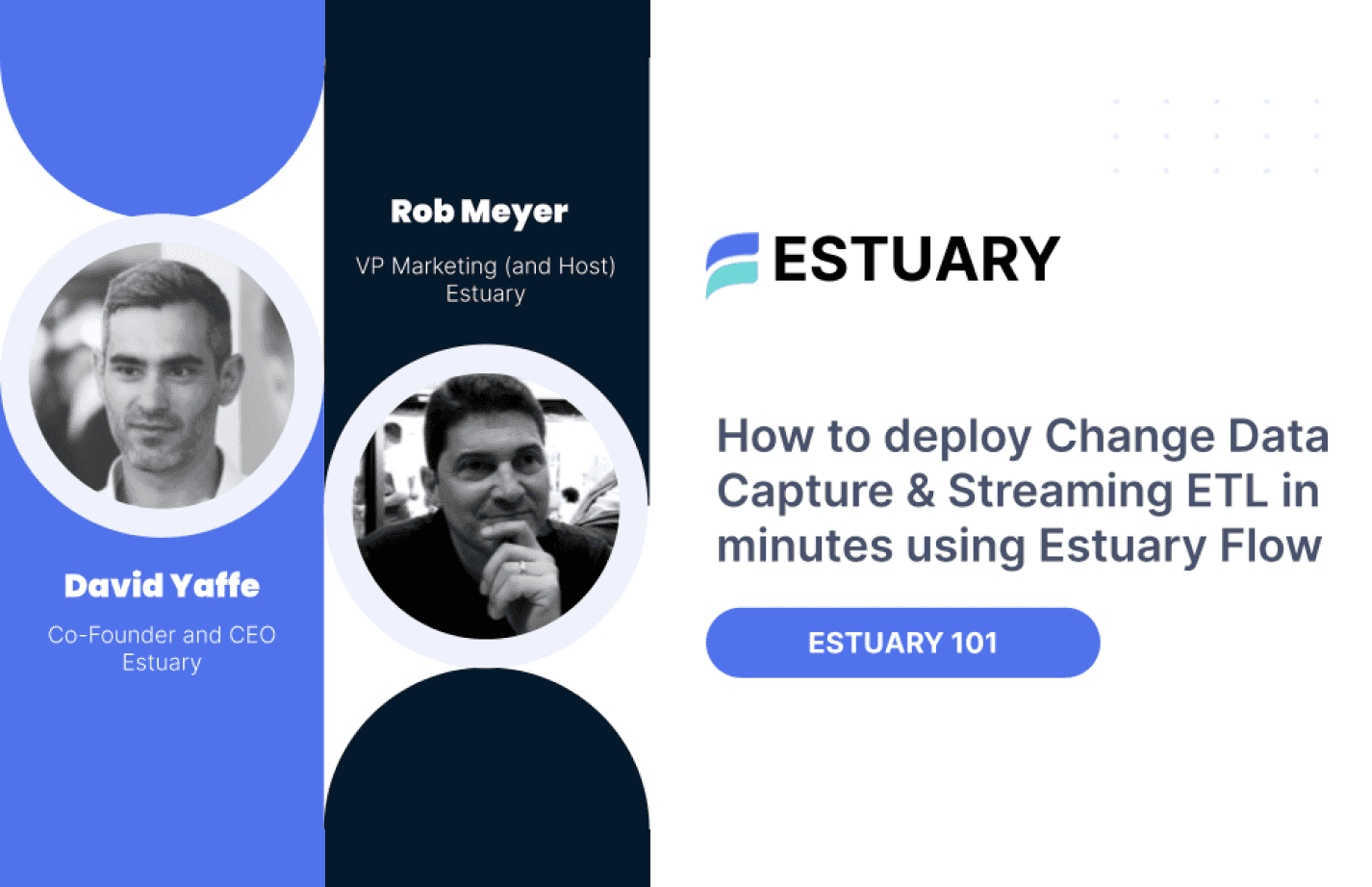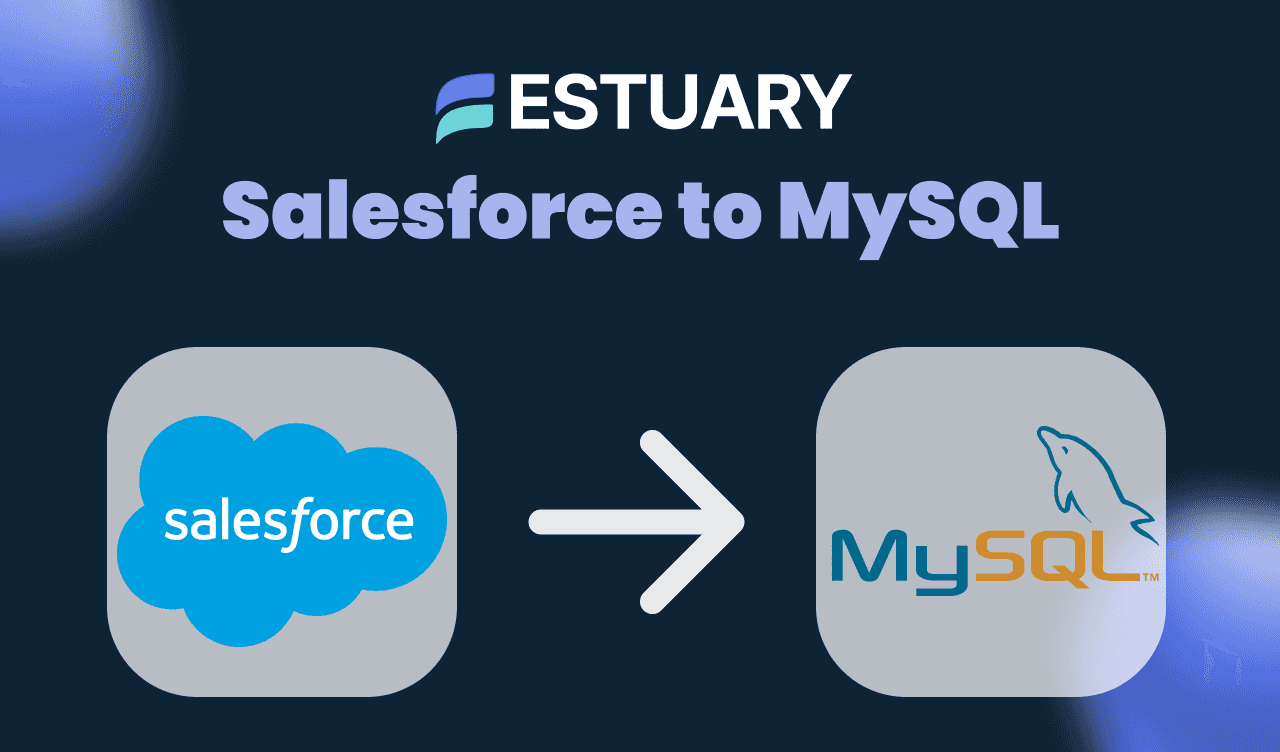
KEY TAKEAWAY
Salesforce data only delivers value when it can move reliably into analytics and operational systems. The right ETL tool removes API limits, schema issues, and manual maintenance, so teams can trust their data and act on it faster.
Here are the top ETL tools for Salesforce:
- Estuary: A Right-Time Data Platform supporting real-time and batch Salesforce syncing with exactly-once delivery, automatic formula field refresh, and predictable volume-based pricing.
- Fivetran: A fully managed ELT platform with automated schema handling and broad Salesforce coverage, best suited for batch-first pipelines.
- Informatica: An enterprise integration platform with deep Salesforce support, event-driven ingestion, and strong governance controls.
- Talend: A flexible ETL solution offering advanced transformations and hybrid deployment for engineering-led teams.
- Skyvia: A no-code, cloud-based ETL and Reverse ETL tool designed for simplicity and SMB-friendly pricing.
The right choice depends on how frequently your Salesforce data needs to move, how much data you manage, and how much operational complexity your team can support.
Introduction
Salesforce is one of the most widely used CRMs, powering sales, marketing, and customer success teams around the world. Every click, opportunity, and customer interaction in Salesforce generates valuable data, but to unlock its full potential, you need to move that data into the right systems for deeper analysis and action.
That’s where ETL tools for Salesforce come in. These platforms allow you to extract Salesforce data, transform it into a consistent format, and load it into destinations like data warehouses, data lakes, or analytics platforms. From real-time dashboards and predictive modeling to building a unified Customer 360, Salesforce ETL is the foundation of a data-driven business.
In this article, we’ll explore the best ETL tools for Salesforce, including Estuary, Fivetran, Informatica, Talend and Skyvia. Each offers a different balance of real-time performance, cost, and enterprise readiness, so you can choose the one that fits your needs.
Why ETL Tools Are Critical for Salesforce
Salesforce is the system of record for customer interactions, but by itself it has limitations. Its built-in reporting works well for campaign-level insights, yet it struggles when teams need to combine Salesforce data with information from marketing, finance, or product systems.
ETL tools extend Salesforce by making it easier to:
- Build real-time analytics dashboards: Sync Salesforce data into warehouses like Snowflake or BigQuery to track leads, conversions, and pipeline performance alongside revenue.
- Create a complete Customer 360: Unify Salesforce data with e-commerce, support, and engagement data to get a single view of each customer.
- Power machine learning models: Deliver fresh Salesforce data into platforms like Databricks for churn prediction, lead scoring, or product recommendation models.
- Enable reverse ETL: Send enriched data such as LTV scores or churn risk back into Salesforce for more personalized sales and marketing campaigns.
In short, ETL tools transform Salesforce from just a CRM into the centerpiece of a data-driven customer strategy, ensuring every team has the information they need at the right time.
Challenges of DIY Pipelines with Salesforce APIs
It is technically possible to build custom pipelines for Salesforce using its APIs, but this approach quickly becomes difficult to manage at scale. Some of the main challenges include:
- API limits: Salesforce enforces strict limits on Bulk API and REST API calls. High-volume pipelines can quickly exhaust these limits, leading to delays or failed syncs.
- Formula fields and custom objects: Many Salesforce deployments rely heavily on formula fields and custom objects. These often require special handling since formula fields do not update record timestamps and may not be captured by standard API calls.
- Schema drift: As Salesforce objects evolve, new fields or changes to existing ones can break custom pipelines without proper schema management.
- Reliability: Handling retries, errors, and partial failures requires significant engineering effort.
- Maintenance overhead: Supporting DIY pipelines means ongoing updates, monitoring, and documentation. This burden grows as more Salesforce objects and destinations are added.
Because of these challenges, most organizations adopt dedicated Salesforce ETL tools that provide pre-built connectors, efficient backfills, schema management, and monitoring out of the box.
Best ETL Tools for Salesforce Integration
If you are exploring ways to move Salesforce data into a warehouse or analytics platform, the right ETL solution can save time and ensure reliability. Some tools focus on batch-based jobs, while others provide real-time streaming capabilities with stronger guarantees on data integrity. Below are five of the most effective ETL tools for Salesforce, each offering different strengths depending on your requirements.
1. Estuary
Estuary is the Right-Time Data Platform that unifies batch and streaming pipelines, giving teams precise control over when data moves — in real time, near real time, or on a schedule. For Salesforce users, Estuary eliminates the complexity of API limits, formula field updates, and schema drift by offering a single, dependable platform for right-time data movement.
Estuary’s Salesforce connector uses Bulk API 2.0 for high-speed initial backfills and REST API for continuous updates. It automatically refreshes formula fields, handles custom objects, and adapts to schema changes, ensuring that your CRM data stays accurate and analytics-ready without manual intervention.
Key Strengths
- Right-time performance: Stream Salesforce data continuously or schedule updates based on business needs.
- Unified data movement: Combine initial backfills with real-time CDC for a complete, consistent dataset.
- Formula field refresh: Keep derived values up to date without exceeding API limits.
- Enterprise-grade security: Deploy in Private Cloud or BYOC environments with VPC peering, PrivateLink, or SSH tunneling.
- Broad ecosystem support: Sync Salesforce data to Snowflake, BigQuery, Databricks, ClickHouse, PostgreSQL, and more.
- No-code simplicity: Configure pipelines visually in minutes, no custom scripts or agents required.
- Predictable pricing: Pay for data volume, not Monthly Active Rows, giving you transparent and scalable costs.
With Estuary, teams can connect Salesforce to any data warehouse or application in right time — powering real-time dashboards, personalized customer experiences, and predictive analytics from a single platform.
👉 Ready to try it? Start syncing Salesforce data with Estuary today.
2. Fivetran
Fivetran is one of the most widely used fully managed ETL and ELT platforms, and it includes strong support for Salesforce integrations. Designed for enterprises that prefer a hands-off approach, Fivetran automates schema management, monitoring, and pipeline reliability so teams can focus on analytics rather than infrastructure.
With Fivetran’s Salesforce connector, you can sync standard and custom Salesforce objects into destinations like Snowflake, BigQuery, or Redshift. It supports production and sandbox environments, offers secure authentication through OAuth2.0 or mTLS, and provides optional features such as Salesforce Files syncing (for Snowflake destinations) and AWS PrivateLink connectivity for Business Critical plans.
Key strengths include:
- Fully managed pipelines with minimal engineering effort.
- Automatic schema evolution when Salesforce fields or objects change.
- Enterprise-grade security with mTLS and PrivateLink options.
- Reliable backfills using Salesforce Bulk APIs for initial data loads.
However, Fivetran comes with some considerations. Its Monthly Active Rows (MAR)-based pricing model can become expensive as Salesforce data volumes grow, and real-time streaming is limited since pipelines are primarily batch oriented. Salesforce API limits also apply, which may require configuration of dedicated read-only users to optimize access.
👉 Explore Fivetran vs Estuary salesforce connector.
3. Informatica
Informatica is an enterprise-grade data integration and management platform widely adopted by large organizations. Its Salesforce Connector, part of Informatica Intelligent Cloud Services (IICS), supports both standard and custom Salesforce objects, as well as big objects in some scenarios. It also integrates with Salesforce’s Bulk API and REST API for large data volumes and incremental syncs.
Key strengths include:
- Deep Salesforce integration: Supports standard, custom, and some big objects as both source and target.
- Event-driven features: Includes PushTopic queries, change events, and custom platform events for event-based syncs.
- Flexible authentication: Offers OAuth, username/password with security token, and other secure methods.
- Enterprise capabilities: Provides strong data governance, transformation, and compliance features through Informatica’s platform.
While Informatica provides powerful capabilities, it is often heavier to deploy and maintain compared to modern SaaS-first ETL tools. It generally requires setting up Secure Agents and involves higher licensing costs, making it better suited for enterprises with complex compliance and governance needs.
4. Talend
Talend is a comprehensive data integration and transformation platform that offers strong support for Salesforce. With pre-built Salesforce connectors, Talend enables organizations to extract, transform, and load Salesforce data into destinations like Snowflake, Redshift, BigQuery, or on-premises databases.
Key strengths include:
- Pre-built Salesforce connectors: Native support for standard and custom objects.
- Scalable ETL: Can handle large datasets through Salesforce Bulk API and incremental syncs.
- Hybrid deployment options: Available as both Talend Open Studio (open source) and Talend Data Fabric (enterprise cloud platform).
- Advanced transformations: Robust ETL pipelines with data quality, cleansing, and governance features.
While Talend offers more flexibility than lightweight tools, it can require additional engineering investment to set up and maintain, especially in self-managed deployments. Its enterprise edition provides a cloud-native platform but comes with higher licensing costs.
Talend is best for teams that need flexible Salesforce ETL with strong transformation and governance capabilities, especially when working in hybrid or multi-cloud environments.
5. Skyvia
Skyvia is a cloud-based no-code data integration platform that supports Salesforce as both a source and a destination. It offers ETL, ELT, and Reverse ETL capabilities, making it a flexible choice for syncing Salesforce data with cloud databases, data warehouses, and SaaS applications.
Key strengths include:
- No-code interface: Build pipelines without writing code, ideal for business users and smaller teams.
- Versatile data flows: Supports ETL, ELT, and bi-directional syncs, including Reverse ETL for pushing warehouse data back into Salesforce.
- Cloud-native: 100% cloud-based platform with no local installation required.
- Affordable plans: Tiered pricing makes it accessible for SMBs while still offering enterprise features in higher tiers.
Limitations include less scalability for very large enterprise workloads compared to platforms like Informatica or Estuary. Still, Skyvia is a good option for teams that want a simple, cost-effective way to integrate Salesforce with other cloud systems.
Salesforce ETL Tools Comparison
Tool | Type | Real-Time Support | Security & Deployment Options | Ease of Use | G2 Rating |
| Estuary | Streaming-first ETL | Yes (exactly-once delivery, Bulk API + REST API, formula field refresh) | Enterprise-ready with BYOC, Private Deployment, VPC peering, PrivateLink, SSH tunneling | No-code, fast setup | 4.8/5 |
| Fivetran | Managed ELT | Limited (batch-first, MAR-based pricing) | Enterprise-grade security, mTLS, PrivateLink for Business Critical plan | Easy, automated | 4.2/5 |
| Informatica | Enterprise ETL/ELT | Yes (supports events, bulk sync, big objects) | Strong governance, compliance, Secure Agent deployment | Complex setup, enterprise-focused | 4.3/5 |
| Talend | Open-source + Enterprise ETL | Partial (bulk + incremental syncs) | Hybrid deployment (cloud or on-prem) | Flexible but requires engineering | 4/5 |
| Skyvia | No-code cloud ETL | Partial (ETL, ELT, Reverse ETL) | 100% cloud-based | Very easy, SMB-friendly | 4.8/5 |
*Ratings from G2. Data reflects most recent available ratings at time of research.
Join companies already unifying Salesforce data with Estuary. Read success stories
Conclusion: Picking the Right Salesforce ETL Tool
Salesforce ETL tools make it possible to connect your CRM with analytics platforms, data lakes, and machine learning systems for deeper insights. Whether you need continuous real-time streaming, scheduled batch syncs, or reverse ETL to push insights back into Salesforce, the right tool depends on your performance, scale, and governance needs.
If your priority is data freshness, security, and predictability, Estuary offers all three. As the Right-Time Data Platform, it lets you control exactly when Salesforce data moves, unify pipelines across systems, and guarantee consistent delivery — without the complexity of managing APIs or custom scripts.
Estuary helps modern teams unlock Salesforce’s full potential by combining real-time analytics with operational agility in a single platform.
Ready to build your first Salesforce ETL pipeline? Sign up here or contact us to get started with expert guidance.
FAQs
Why do companies use ETL tools instead of Salesforce’s native APIs?
What are the most common challenges when integrating Salesforce data?

About the author
Team Estuary is a group of engineers, product experts, and data strategists building the future of real-time and batch data integration. We write to share technical insights, industry trends, and practical guides.















